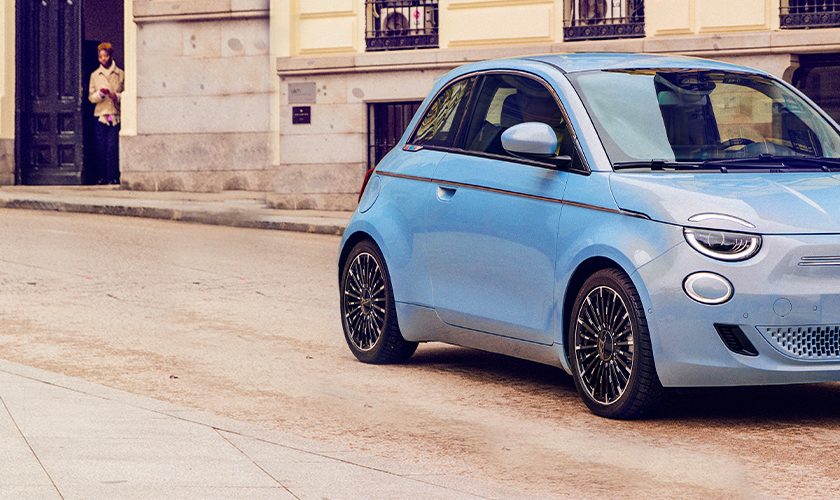Chris Riley tests the 2024 Fiat 500e La Prima electric small car with pricing, specs, ride and handling, safety, verdict and everything the over-50 driver needs to know.
Summary: The Fiat 500e is one of the cutest cars on the road. While it will only ever be a niche player, we can see it appealing to a lot of people.
2024 Fiat 500e La Prima small EV
Price: $52,500 (plus on road costs)
Options: premium paint (all but Ice White and Celestial Blue) $700, tri-colour paint with ceramic coating $1600
Warranty: Three-years, 150,000km. Battery: eight-years/150,000km
Safety: four Euro NCAP stars (2021)
Build location: Italy
Engine: front mounted electric motor
Power: 87kW
Torque: 220Nm
Transmission: single speed automatic, front-wheel drive
Body: 3632mm (long); 1683mm (wide); 1527mm (high)
Kerb weight: 1440kg
Ground clearance: 130mm
Braked towing capacity: 800 kg Surely you wouldn’t even consider it!
Boot capacity: 185 litres But it’s 550 litres with the rear seats folded
Wheels: 17-inch alloy
Tyres: 205/45 R17
Spare wheel: tyre mobility kit
Turning circle: 9.3m Few cars can match that
Battery capacity: 42kWh
Charge time: 0-80 percent (fast charger) 35 minutes, wallbox 11kW DC charger four hours, 240V/10A (domestic) 21 hours 30 minutes
Claimed range: 311km In the real world, it’s considerably worse
Official consumption: 15.9kWh/100km
Consumption on test: 14.2kWh/100km (199km), 15.2kWh/100km (2000km)
seniordriver consumption on test: 13.8kWh/100km (256km)
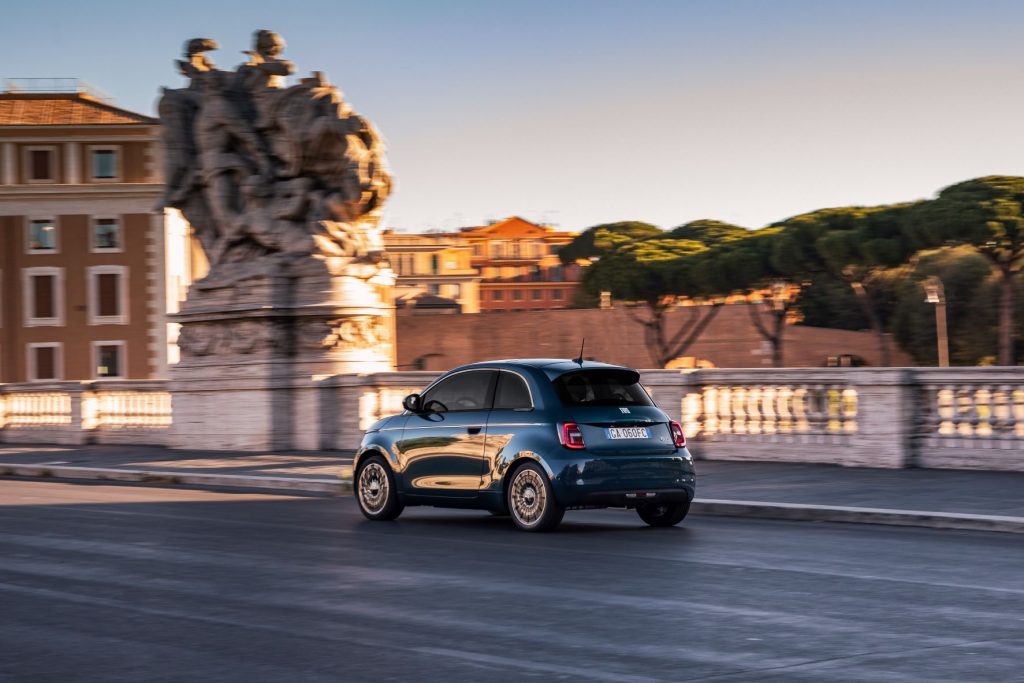
[review]
The Fiat 500e has got it all.
It’s Italian, really cute and fun-to-drive – and the most-awarded vehicle the company has ever produced.
It even sports a new logo, re-designed to incorporate an “e” designating that it’s an electric vehicle.
Fiat proudly claims the 500e or New Fiat 500 as it is also known is the first fully-electric model in the history of the brand.
That may be so but it seems to have overlooked the Fiat Panda Elettra (Electra), introduced in early 1990.
The two-seater was also fully electric, with a 14kW DC motor, a top speed of 65km/h and range of up to 100km.
Needless to say, with those kinds of specs the Elettra was something of a disaster and was quietly withdrawn in 1998.
The current 500e has actually been in production since 2013.
A second-generation electric 500 was introduced in early 2020 and launched in Europe as the New Fiat 500.
It’s the first time the 500e has been offered in Australia.
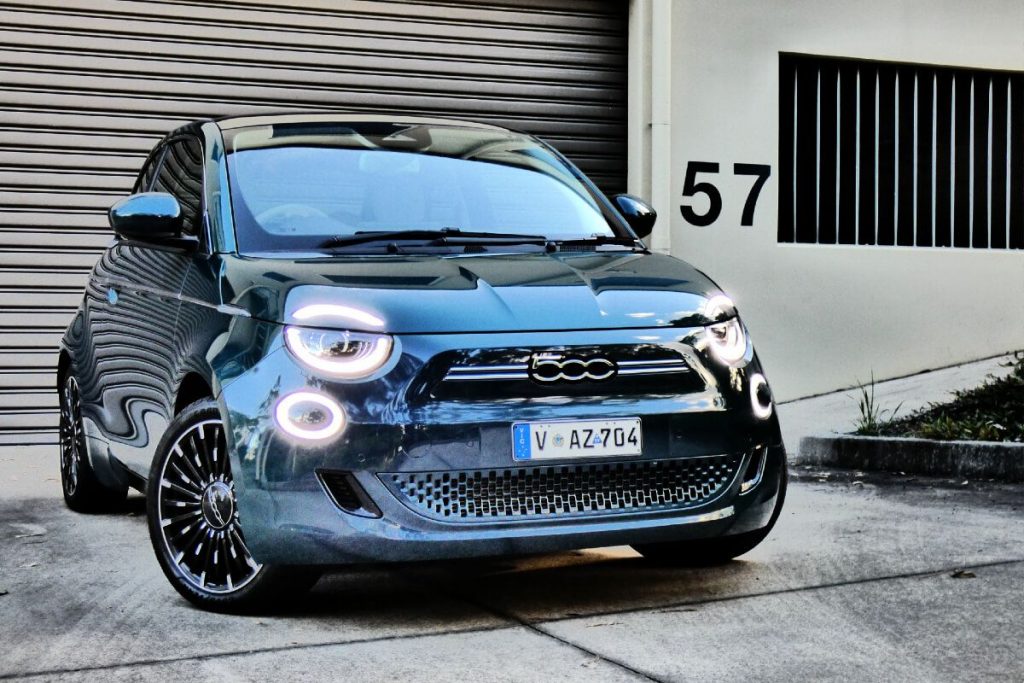
What’s it cost?
The Fiat 500e La Prima is priced from $52,500 plus on-roads.
The 500e is slightly larger than its petrol-powered sibling, at 3632mm long, 1683mm wide and standing 1527mm tall.
With a 2322mm wheelbase it sits on a completely new bespoke platform that is not shared with any other product from the Stellantis portfolio.
It’s obviously a small car with a tiny boot to match (185 litre) and no so-called secondary ‘frunk’ in the front.
It’s available in six colours, with diamond cut, glossy black 17-inch alloys, with LED DRL ‘eyebrows’ and LED blinkers positioned between the bonnet and fenders, combining to make the Fiat 500e instantly recognisable.
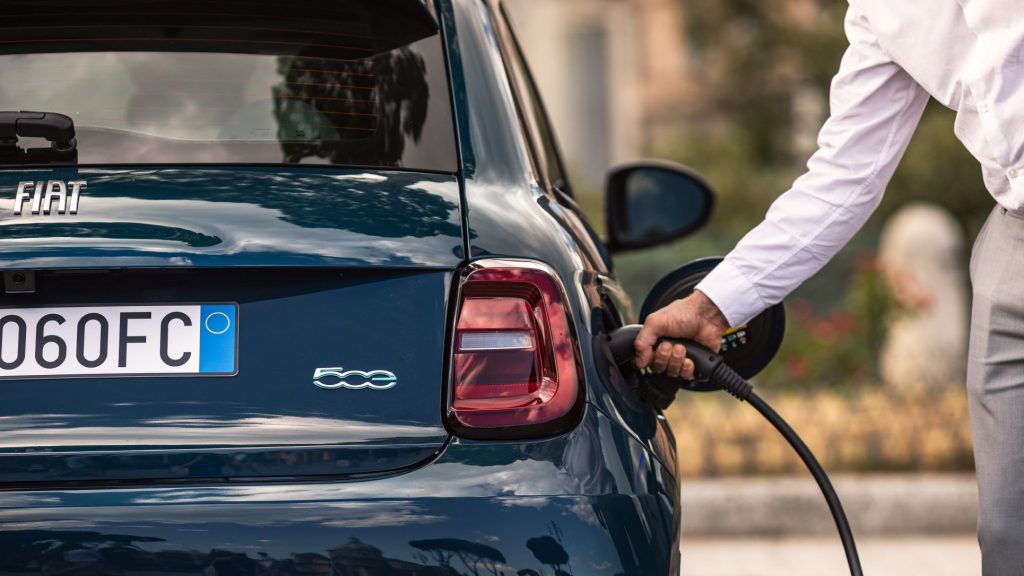
The six colours are all inspired by nature: Ice White, Onyx Black, Ocean Green, Mineral Grey, Rose Gold and Celestial Blue.
Any colour other than Ice White or Celestial Blue attracts a $700 premium paint charge – tri-colour paint is $1600.
Fiat 500e will be available in one trim option, featuring single climate air, Fiat monogramed artificial leather, two-colour soft touch steering wheel and premium cloth dashboard trim and heated, manual-adjust front seats.
There’ also keyless entry and go, high beam assist, adaptive cruise control, tyre pressure monitoring, auto dimming rear view mirror, auto lights and wipers and privacy glass.
A largish glass sunroof is also standard, but the cloth mesh screen is not going to keep out the summer heat.
The doors open at the push of a button rather than with a conventional latch.
The driver sits facing a circular 7.0-inch instrument cluster which is digital and offers two themes.
Infotainment consists of a 10.25-inch touchscreen with Bluetooth, built-in satnav, AM/FM and DAB+ digital radio, wireless Apple CarPlay and Android Auto, plus six-speaker audio.
There’s three USB ports. 1 x USB-A and 1 x USB-C port together with a 12-volt outlet in the console box plus another USB-A port at the front of the console, along with a wireless phone charge pad.
In an interesting touch the charge pad is embossed with a relief of the Turin skyline (where the car was designed).
The 500e features Autonomous Driving Level 2 which means it can control both steering and acceleration/deceleration, but cannot or is not permitted to drive itself for more than a brief period.
A forward-looking camera, located behind the internal rear view mirror, supports longitudinal and lateral control, performing intelligent Adaptive Cruise Control (iACC) and Lane Centring (LC).
500e was crash-tested by Euro NCAP in 2021 when it received a disappointing four out of five stars for safety.
Safety consists of six airbags (front, side and head), a rear view parking camera, autonomous emergency braking (pedestrian and cyclist detection), AEB Junction Assist for car-to-pedestrian scenarios.
A lane support system with lane keep assist (LKA), lane departure warning (LDW) and emergency lane keeping (ELK) are also standard as is Blind spot monitoring (BSM).
AEB Backover is not available.
What it doesn’t get is a centre airbag, rear cross-traffic alerts and reverse auto braking.
The 500e is covered by an outdated three-year/150,000km warranty, with a separate eight-year/150,000km warranty for the EV battery pack.
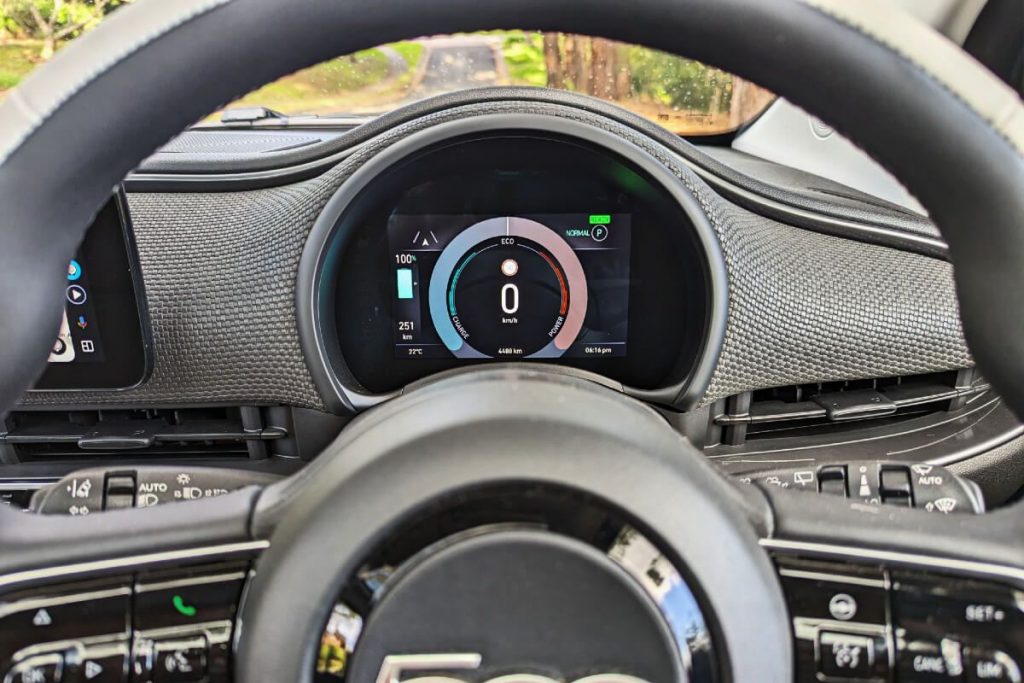
What’s it go like?
The inside looks just as cool as the outside, but don’t look too closely or you’re likely to find plenty of hard plastic.
The doors are large and open wide but will not remain open on anything more than a slight incline.
Ditto the front passenger seat which does not remain locked when pushed forward for rear access.
And, with limited head and leg room, you’re going to struggle to fit full-size adults in the back.
In fact, we were forced to move the driver’s seat forward to accommodate a six-year-old in a car seat.
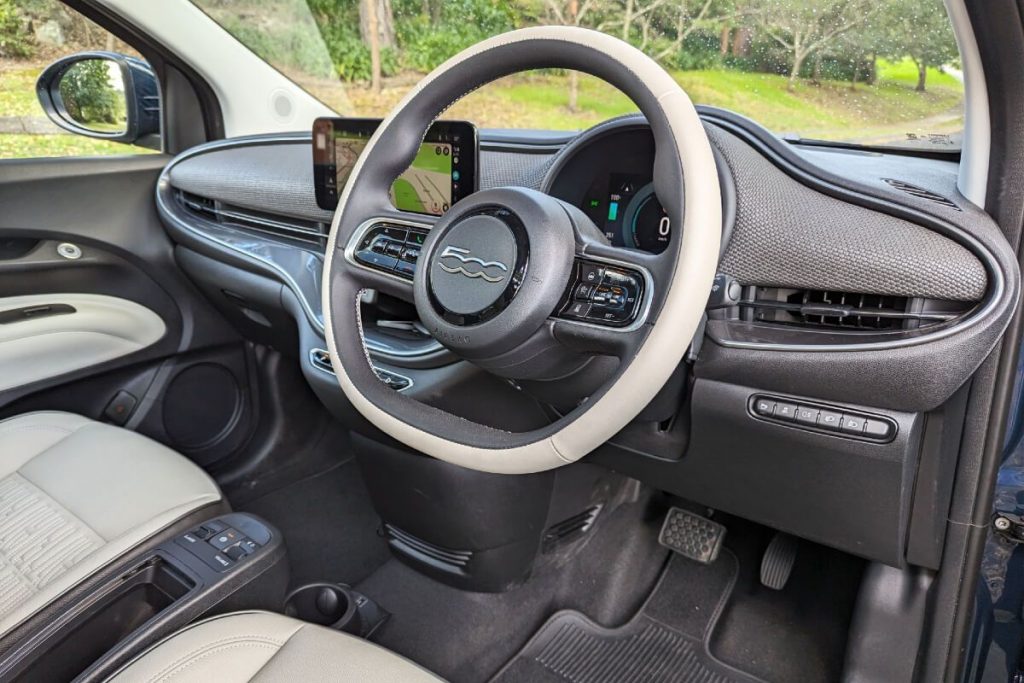
The cloth trim covering the face of the dashboard looks like it will accumulate dust and become sticky with age.
The original Fiat 500 from 1957, nicknamed the Bambino, featured a tiny rear-mounted 500cc two-cylinder engine that produced just 9.7kW.
Our family actually owned a second-hand, white-coloured example, complete with folding fabric roof and doors that opened in a reverse direction.
A lucky few punters scored the high performance Abarth version, produced from 1964, with a larger 700cc engine and almost triple the power output at 28kW.
The modern version of the car was launched in 2007, as a competitor for the likes of the New Beetle and re-imagined BMW Mini.
The 500e is equipped with a front-mounted electric motor that produces 87kW of power and 220Nm of torque, and is powered by a 42kWh lithium-ion battery (37.3kWh of which is usable).
Power is fed to the front wheels though a typical EV-style one-speed auto.
Given the cutting-edge electric technology that underpins the 500e, one might expect more from the basics.
But, like the petrol model, it features old-school drum brakes at the rear and relatively simple torsion beam suspension.
Perhaps it was an attempt to keep the cost of the car down.
The 87kW electric motor is enough to push the tiny newcomer from 0-100km/h in 9.0 seconds and on to an electronically limited top speed of 150km/h.
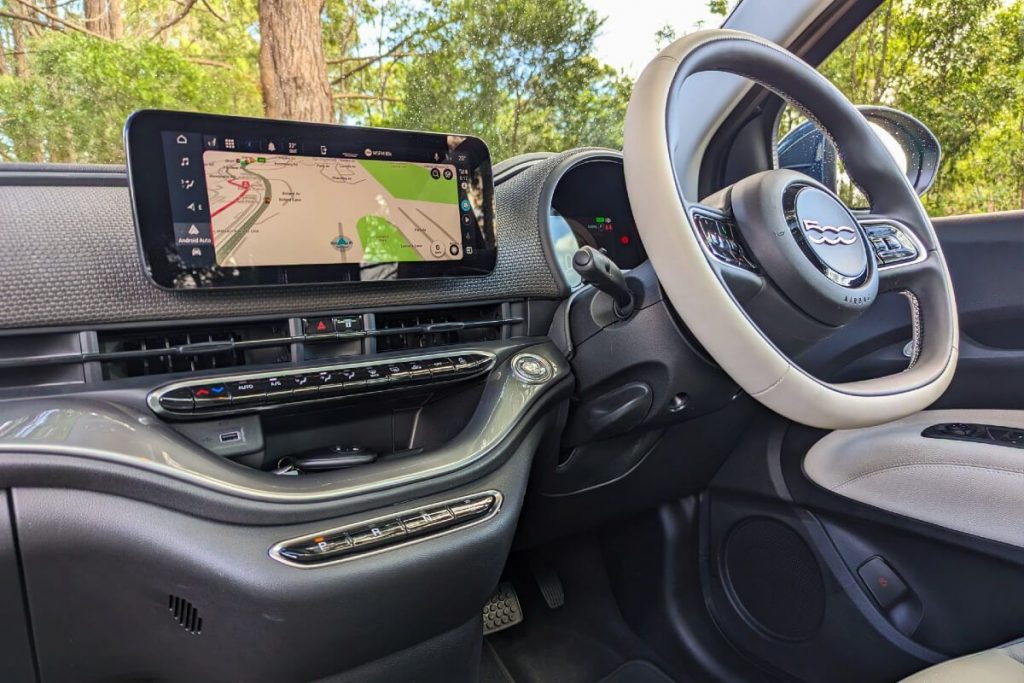
Gear selection is via a row of push buttons below the touchscreen, with park engaging the handbrake automatically.
There’s no gear change paddles, but you do get three drive modes (Normal, Range and Sherpa).
Sherpa is an energy-maximising mode, even better than Range, but limits things like speed and acceleration, and caps maximum speed at 80km/h.
It also turns off the air conditioning and disables the charge pad.
Range mode is the best option and introduces one-pedal driving which slows the car as soon as the driver reduces pressure on the accelerator.
It takes the tedium out of constantly switching between brake and accelerator in stop-start city driving.
But it can be a pain when you’re trying to reverse.
The 500e supports three different charging modes and is equipped with a CCS COMBO Type 2 socket with support for AC and DC fast charging.
A DC fast charging rate of 85kW is offered with a zero to 80 percent charge taking 35 minutes.
Maximum AC charging with a wallbox at home or work is 11kW, with 20 to 80 percent taking a little over four hours.
If you only have access to a standard 240V/10A domestic plug, you’re up for 21 hours and 30 minutes to fully charge the battery.
The problem is that the car comes only with a double-ended Mode 3 cable, so you’re not going to be able to plug in at home without a wallbox.
This cable is stored in a shallow cubby below the luggage area, but requires some manipulation before the lid will shut.
Not sure, however, where the re-inflation kit that we found in a bag on the floor behind the driver’s seat is supposed to go.
In terms of performance, the 500e gets along confidently.
It’s quick out of the blocks and has no trouble holding its own on the motorway.
Steering is direct but touchy while the brakes can be abrupt if you’re not careful.
The ride can become bouncy due to the weight of the car and slow spring recovery rate.
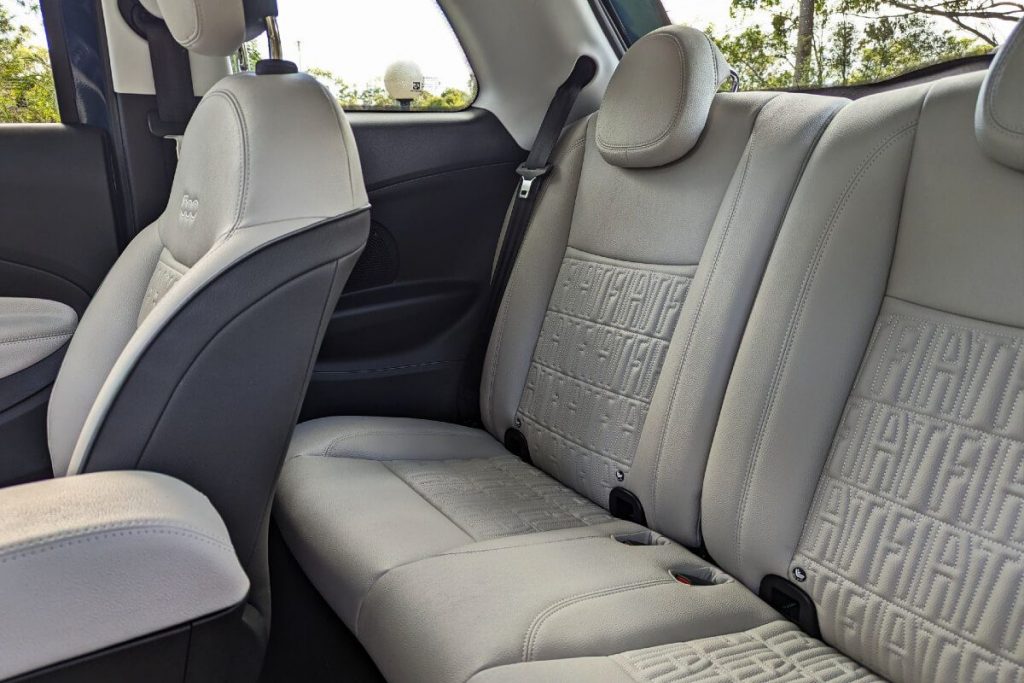
The 500e has a claimed range of 311km (WLTP).
Fully charged, however, the computer in our test vehicle showed an initial 268km.
The car uses a claimed 15.9kWh/100km.
That’s about the same as a Mini Cooper SE which is rated at 15.8kWh/100km (but has less range).
To give these figures some context, the market leading rear-drive, single motor Tesla Model 3 is good for 13.9kWh/100km.
Based on an average 50km per day of driving, Fiat claims a full charge is enough for a working week.
We clocked up almost 500km and were forced to charge the car twice during our week of tenure.
This included a return trip between Newcastle and the Blue Mountains in NSW which proved a little daunting.
With a full charge and range of 246km indicated, we calculated that we would have 15 or 20km to spare.
As it turned out, the return 199km trip used 80 percent of our charge, at a rate of 14.2kWh/100km – with 42km left in the tank.
What we neglected to factor in was time spent in Sherpa mode in the NorthConnex tunnel which consumed virtually no power at 80km/h.
Recharging the car using a public AC charger took about 3.5 hours at a cost of $17.49 at a rate of 51 cents a kWh.
Long term the computer showed the car was averaging 15.2kWh/100km after more than 2000km.
What we like
- Italian
- Incredibly cute
- Fun to drive
- Environmentally friendly
What we don’t like
- Costs too much
- Limited range
- Not very practical
- No home charge cable
- Tyre repair kit
- Large wide opening doors
- Six-speaker unbranded audio
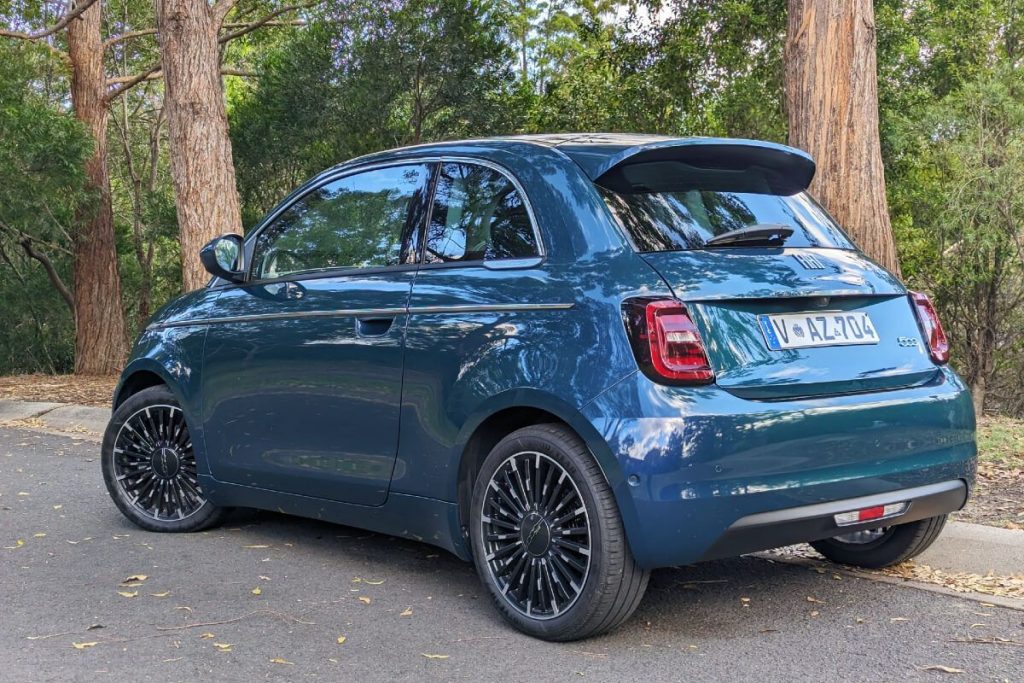 What over-50 drivers need to know
What over-50 drivers need to know
It might be incredibly cute, but the Fiat 500 has never been a big seller here.
That makes the electric version at almost double the price a mighty big ask, especially with better-featured Chinese EVs available – and for less.
None of them, however, come with the Fiat name or heritage.
Mature drivers with plenty of money to spare might find the little Fiat an attractive proposition, that is if they are city dwellers and travel short distances.
It’s compact, easy to drive and has a simple control set and the grandkids will adore it – if they can fit in the back.
Congratulations to Fiat Australia for taking such a huge and potentially risky step into the future (perhaps it wasn’t given a choice).
seniordriver comments
The little Fiat appealed to us far more than we expected it to.
It’s interesting that Stellantis has decided to offer a single variant in Australia, especially when overseas markets get a more affordable model, the 500e City Range (with a smaller battery … we suspect the smaller battery would make it suitable for ducking down your driveway to collect the mail, and not much else!)
Although the $52,500 asking price seems steep, it starts to make more sense when you compare it with what else is available. And the simple answer is: not much. The Chinese alternatives such as the MG4 and GWM Ora aren’t much cheaper, especially the top end models. The Fiat is $7490 less than the Cupra Born EV and fully $12,475 less than the Nissan Leaf e+, although both the Cupra and Nissan have two extra doors and rear seats that real people can use.
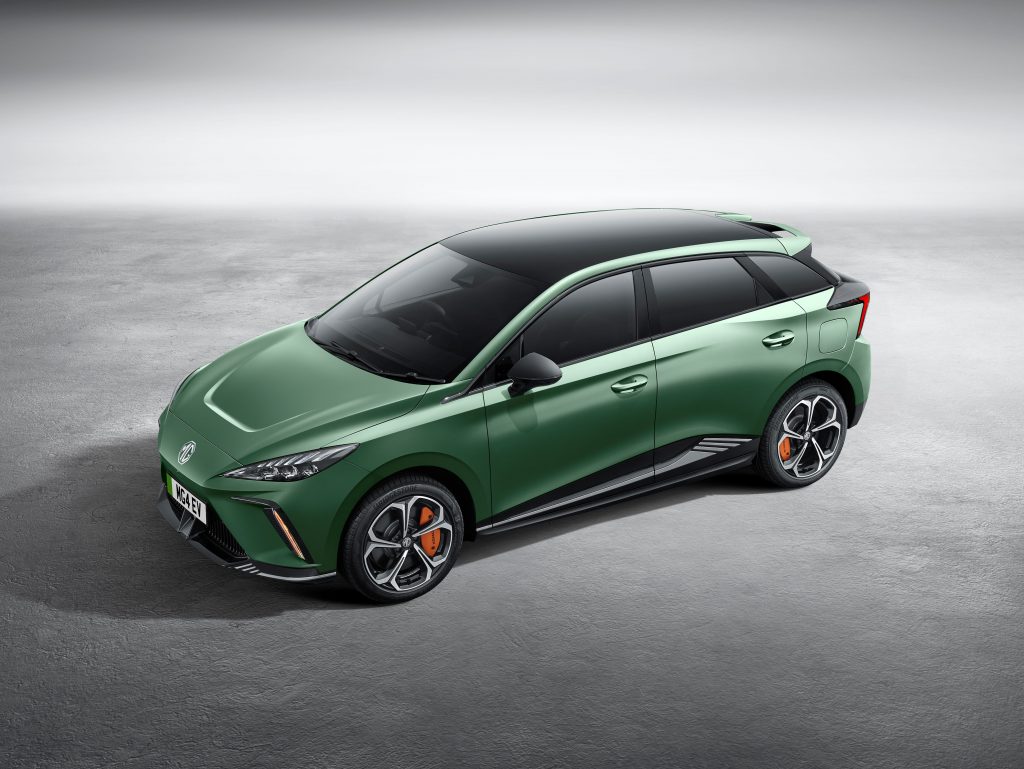
Inside the 500e is a much nicer place to be than the other Fiat 500s and there’s a palpable feel of quality and style. That silly mesh cover over the sunroof, however, is going to be regularly cursed every time the outside temperature starts to rise.
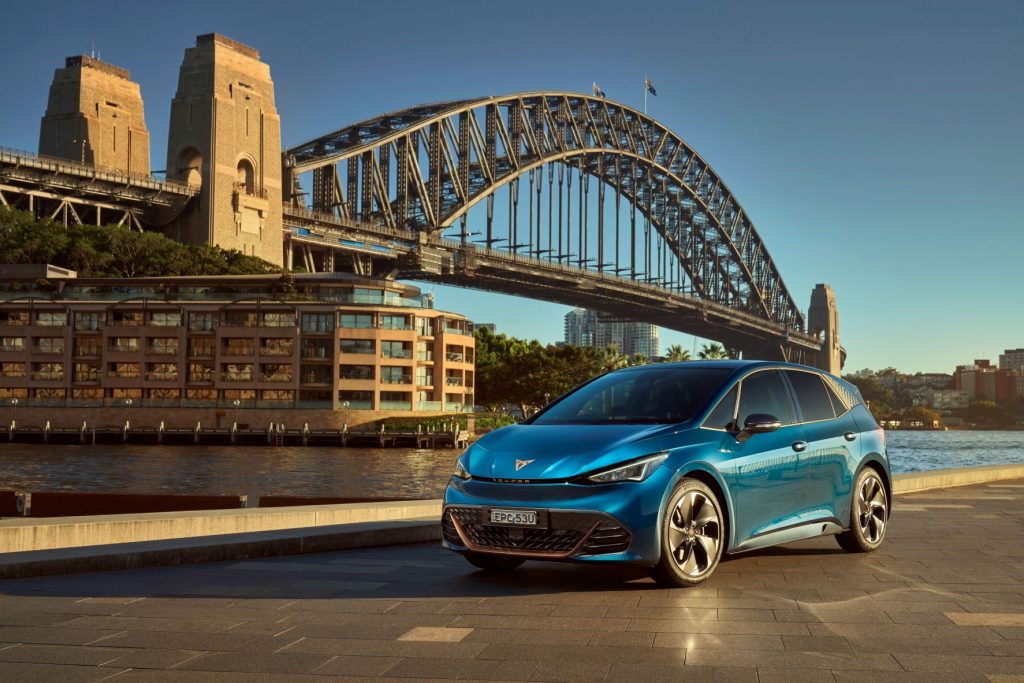
The boot is tiny, although sufficient to carry home the weekly shop, particularly if you’re a whizz at Tetris. Perhaps better to leave the rear seats folded (although annoyingly, they don’t fold flat) and make full use of the 550 litres of space they free up.
seniordriveraus managed even worse range figures than Chris. When we collected the car, the predicted range, with the battery charge at 87 percent, was a meagre 211km in Normal mode. Fully charged, the readout in Sherpa mode (which nobody in their right minds would want to use) was just 260km – a long way short of the claimed 311km. It was even worse in the other modes.
Another niggle is the paltry (by modern standards) warranty of just three years. The battery is covered for eight years or 160,000km.
